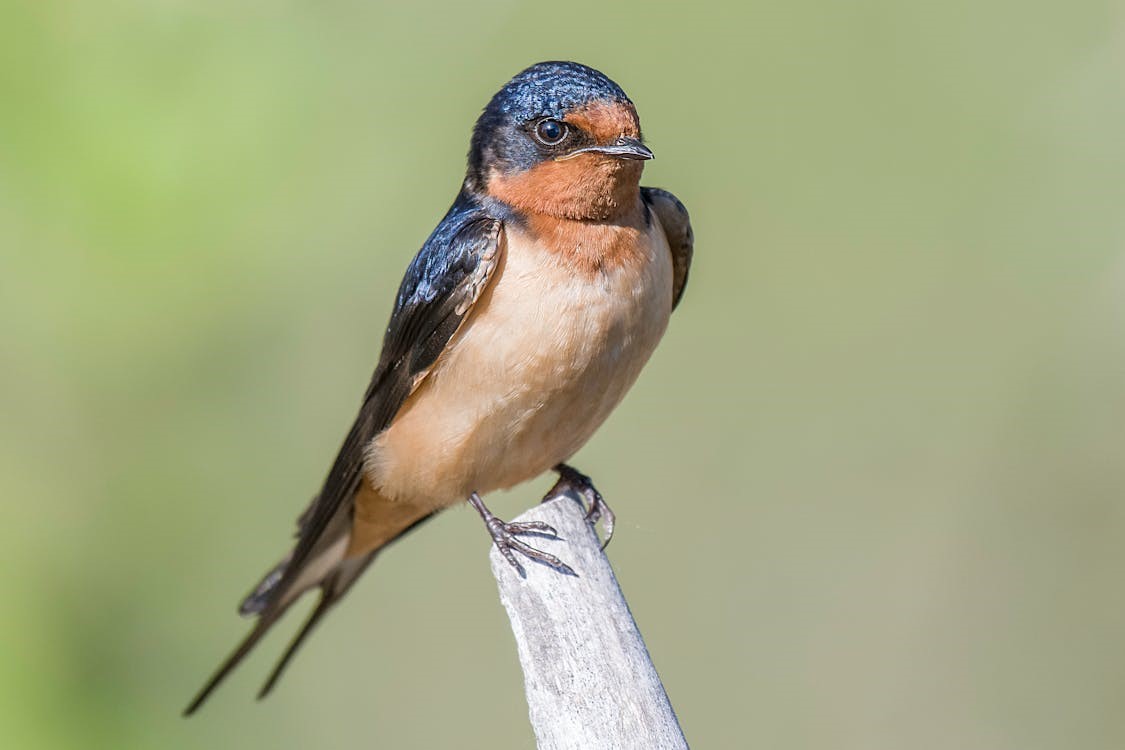Barn Swallow
Hirundo rustica
Compiled by Lindsey Hernandez
Photo by Mike Kit
The Barn Swallow is the most abundant and widely distributed swallow species in the world. It breeds throughout the Northern Hemisphere and winters in much of the Southern Hemisphere.
According to legend, the Barn Swallow got its forked tail because it stole fire from the gods to bring to people. An angry deity hurled a firebrand at the swallow, singeing away its middle tail feathers.
When perched, the sparrow-sized Barn Swallow appears cone shaped, with a slightly flattened head, no visible neck, and broad shoulders that taper to long, pointed wings. The tail extends well beyond the wingtips and the long outer feathers give the tail a deep fork. They have a steely blue back, wings, and tail, and rufous to tawny underparts. The blue crown and face contrast with the cinnamon-colored forehead and throat. White spots under the tail can be difficult to see except in flight. Males are more boldly colored than females.
The Barn Swallow can be found from open habitats from fields, parks, and roadway edges to marshes, meadows, ponds, and coastal waters. Their nests are often easy to spot under the eaves or inside of sheds, barns, bridges and other structures. In Austin, their nests can be found in parking garages or under MoPac bridges.
Barn Swallows once nested in caves throughout North America, but now build their nests almost exclusively on human-made structures. Today the only North American Barn Swallow population that still regularly uses caves as nest sites occurs in the Channel Islands off the California coast.
Like the other two members of its genus, the Barn Swallow rapidly expanded its breeding range in Texas, beginning in the 1960s; this expansion is strongly related to road-building practices that began during that time-frame.
Barn Swallows feed on the wing, snagging insects from just above the ground or water to heights of 100 feet or more. They fly with fluid wingbeats in bursts of straight flight, rarely gliding, and can execute quick, tight turns and dives. When aquatic insects hatch, Barn Swallows may join other swallow species in mixed foraging flocks.
Barn Swallows are long-distance migrants and up until the end of the eighteenth century scientists such as Aristotle believed that swallows either buried themselves under vegetation or water throughout the winter. Other scientists believed swallows hung upside in caves. In 1703, scientist Charles Morton believed that birds flew to the moon during winter. For many years, this was the widely accepted explanation for the swallows’ winter disappearance. Poet John Gay wrote in his 1773 poem Saturday; or, the Flights:
“Or to the moon in midnight hours ascend.
Where swallows in the winter season sleep”
Barn Swallows actually fly from North American breeding grounds to wintering areas in Central and South America. Southbound fall migration may begin by late June in Florida or early July in Massachusetts. Barn Swallows enter the southern United States in mid-March to mid-April and reach the northern portions of their range by early June.
Males arrive on the breeding ground earlier than the females and establish small territories which contain perches and potential nest sites. Courtship takes place in aerial displays in which each male attempts to lead a female to one or more nest sites.
Sources: Texas Breeding Bird Atlas, All About Birds, The Dublin Penny Journal and Texas Parks and Wildlife.




